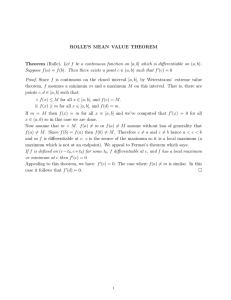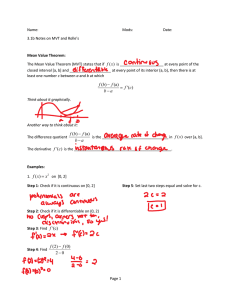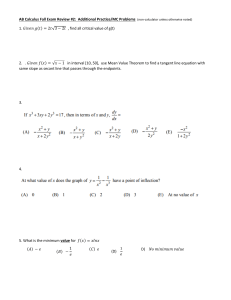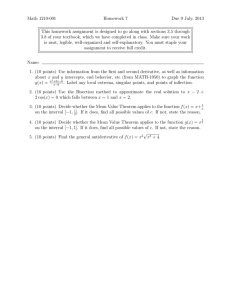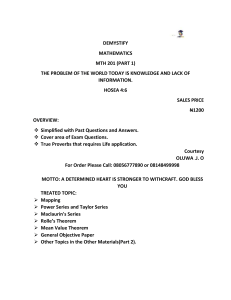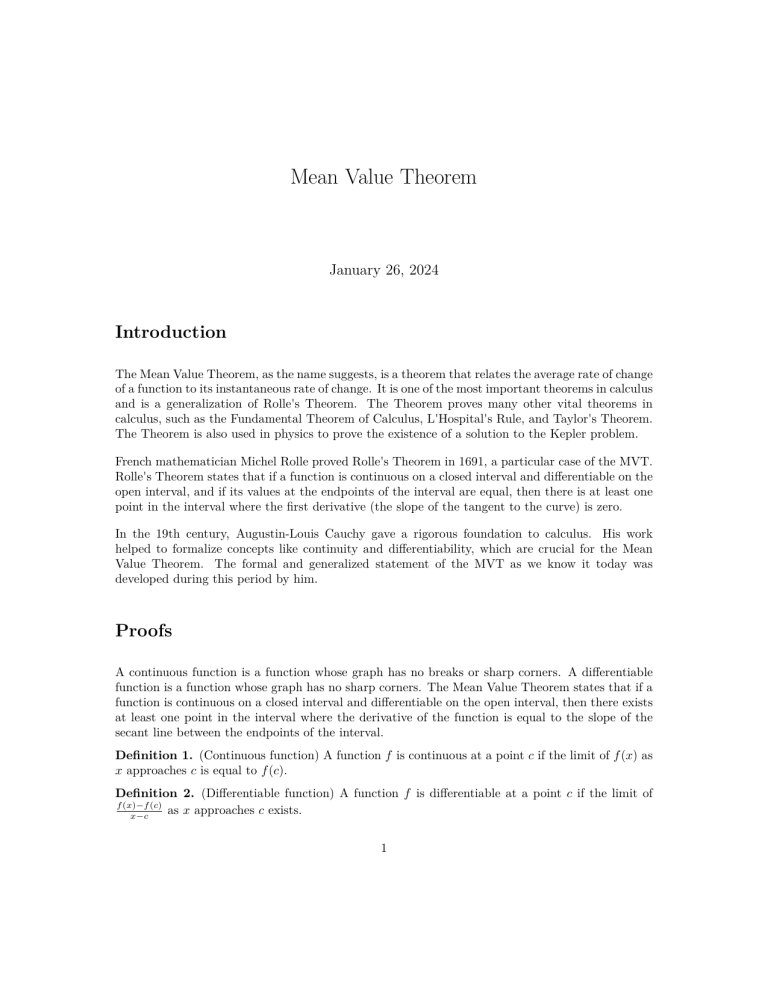
Mean Value Theorem January 26, 2024 Introduction The Mean Value Theorem, as the name suggests, is a theorem that relates the average rate of change of a function to its instantaneous rate of change. It is one of the most important theorems in calculus and is a generalization of Rolle's Theorem. The Theorem proves many other vital theorems in calculus, such as the Fundamental Theorem of Calculus, L'Hospital's Rule, and Taylor's Theorem. The Theorem is also used in physics to prove the existence of a solution to the Kepler problem. French mathematician Michel Rolle proved Rolle's Theorem in 1691, a particular case of the MVT. Rolle's Theorem states that if a function is continuous on a closed interval and differentiable on the open interval, and if its values at the endpoints of the interval are equal, then there is at least one point in the interval where the first derivative (the slope of the tangent to the curve) is zero. In the 19th century, Augustin-Louis Cauchy gave a rigorous foundation to calculus. His work helped to formalize concepts like continuity and differentiability, which are crucial for the Mean Value Theorem. The formal and generalized statement of the MVT as we know it today was developed during this period by him. Proofs A continuous function is a function whose graph has no breaks or sharp corners. A differentiable function is a function whose graph has no sharp corners. The Mean Value Theorem states that if a function is continuous on a closed interval and differentiable on the open interval, then there exists at least one point in the interval where the derivative of the function is equal to the slope of the secant line between the endpoints of the interval. Definition 1. (Continuous function) A function f is continuous at a point c if the limit of f (x) as x approaches c is equal to f (c). Definition 2. (Differentiable function) A function f is differentiable at a point c if the limit of f (x)−f (c) as x approaches c exists. x−c 1 Theorem 1. (Mean Value Theorem) If a function f is continuous on a closed interval [a, b] and differentiable on the open interval (a, b), then there exists at least one point c in (a, b) such that f ′ (c) = f (b) − f (a) . b−a Proof: Using Rolle's Theorem Lemma 2. (Rolle's Theorem) If a function f is continuous on a closed interval [a, b] and differentiable on the open interval (a, b), and if f (a) = f (b), then there exists at least one point c in (a, b) such that f ′ (c) = 0. Proof. For the function f , since it is continuous, it must have a maximum and minimum value on the interval [a, b]. Let M be the maximum value and m be the minimum value. If M = m, then f is a constant function and f ′ (c) = 0 for all c in (a, b). If M ̸= m, there will be two cases. Case 1: M = f (a) or M = f (b). Without loss of generality, assume M = f (a). Since f (a) = f (b), f must have a minimum in the interval (a, b). Let c be the point where f attains its minimum value. Thus, f ′ (c) = 0. Case 2: M ̸= f (a) and M ̸= f (b). Since f is continuous on [a, b], by the Extreme Value Theorem, f must attain its maximum and minimum values on [a, b]. Let c be the point where f attains its maximum value. Thus, f ′ (c) = 0. After proving Rolle's Theorem, we can prove the Mean Value Theorem using Rolle's Theorem. Proof. Consider the function: g(x) = f (x) − We put a in: g(a) = f (a) − f (b) − f (a) (x − a) b−a f (b) − f (a) (a − a) = f (a) b−a Then we put b in: f (b) − f (a) (b − a) = f (a) b−a Since g(a) = g(b), by Rolle's Theorem, there exists at least one point c in (a, b) such that g ′ (c) = 0. We have )′ ( f (b) − f (a) (f (b) − f (a)) (x − a) ′ ′ = f ′ (x) − g (x) = f (x) − b−a b−a g(b) = f (b) − Thus, for the point c in (a, b), we have g ′ (c) = f ′ (c) − f (b) − f (a) =0 b−a 2 Therefore, f ′ (c) = f (b) − f (a) b−a 3

